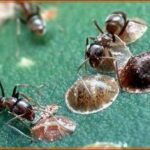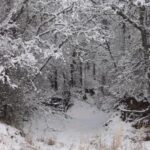According to Donald Lewis, an extension entomologist at Iowa State University, although there are other types of big black ants, when you refer to these types of ants you are usually referring to carpenter ants. Carpenter ants burrow into the wood in your home and in trees and can cause a lot of damage. Knowing about these ants will help you to identify a potential ant problem in and around your home.
Description
Carpenter ants can vary in their look depending on their classification. According to the University of Minnesota Extension, there are four main classifications of theses ants including the queen, the winged male, the major worker and the minor worker. Regardless of their classification, all carpenter ants have an even thorax, which is the upper segment of their body located directly behind their heads. The Queen is larger and are often a full inch in size. The winged males are smaller than the queen and have a set of wings attached to their thorax. While both the major and minor worker are smaller than the winged male. The major worker is larger than the smaller minor worker.
Their Home
Carpenter ants live in wood that is moist, such as trees that are rotting or logs that are partially buried in the ground. It is also common to find them living in buildings where the wood is decaying or damp. The ants burrow through the wood making tunnels that can weaken and destroy dead wood. Unlike termites, they do not eat the wood but instead move it out of the nest. The resulting tunnels are smooth and look as though they have been sanded. Depending on the size of the colony the damage can be minor or more serious.
Food Source
As previously mentioned, carpenter ants do not eat wood. They choose food sources that contain proteins and sugars. Usually, they choose to feed on insects, both living and dead. Another favorite food for them is honeydew, which a liquid produced by scale insects such as aphids. If the ants move into your home, they will also eat things found in your kitchen such as meats, honey and jelly.
Prevention
Carpenter ants can be prevented. Most importantly, wet, damaged should be replaced. Also, firewood piles should be kept away from your home as well as away from trees. This will keep the ants in the wet firewood instead of your home or healthy trees. You can also remove tree stumps to discourage rotting wood that may attract a new colony.
Control
The first step to controlling infestations is to remove wet and damaged wood from your property, regardless of if it is lumber or tree stumps or part of a building. Insecticides containg bifenthrin, cyfluthrin or permethrin can be used to treat the outside of your home or you can hire a professional exterminator to treat the inside or more serious infestations. However, according to the University of Minnesota extension, unless the ants are infesting your home, treating a tree is not necessary for the benefit of the tree, since the ants will not harm the health of the tree. Once a colony begins to infest your home, treatment is necessary to prevent damage to the construction of the building.
Ohio State University Extension Fact Sheet: Ants in and Around Your Home http://ohioline.osu.edu/hyg-fact/2000/2064.html
Iowa State University Extension: Carpenter Ants in Trees http://www.extension.iastate.edu/news/2009/jun/060503.htm
University of Minnesota: Carpenter Ants http://www.extension.umn.edu/distribution/housingandclothing/dk1015.html






